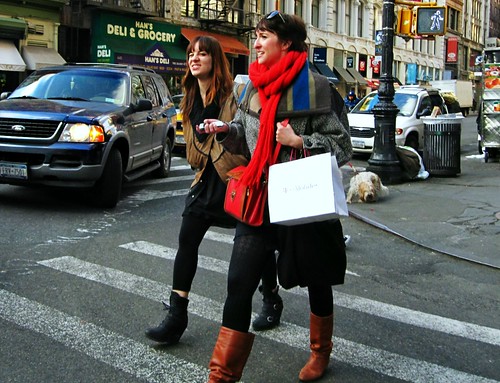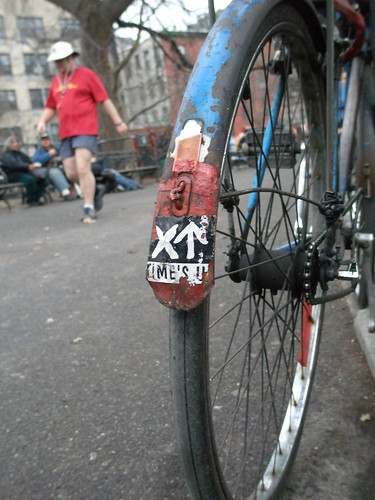If you had to identify one defining feature of life in Manhattan, it just might be pedestrianism. There are places where calling someone or something “pedestrian” is an insult; this isn’t one of them. Here, “pedestrian” is an identity to share and be proud of. It does occasionally need defending.
Only a minority of us have cars, but every New Yorker walks and lives near things worth walking to (no matter how often we also take taxis or Zipcars or anything else). Our street grid, formed by the 1811 Commissioners’ Plan, predates the automotive invasion of American space by nearly a century. We’re the pre-automotive Americans, by design and by history as well as by inclination. And if factors like climate change, oil shortages, energy costs, Middle Eastern warfare, and rising awareness of what cars do to human bodies all suggest that the automotive era won’t last forever, we’re ready for post-automotive life, too.
On the East Side, the human/vehicular competition is particularly intense, and with the tire tracks on people’s backs to prove it, a coalition of community groups led by the nonprofit group Transportation Alternatives (along with the East Village Community Coalition, East Harlem Preservation, Civitas, Upper Green Side, and others) has developed an East Side Action Plan to define goals for the improvement of street safety involving multiple city agencies. The East Side, particularly the East Village, is a logical place for this: the area from Chinatown up to East Harlem accounts for only 8 percent of the city’s population but 22 percent of its pedestrian commuters, 13 percent of its bike commuters – and 11 percent of its “fatal and injurious” crashes.
With demographics skewed toward children and seniors, but also with wide avenues, a 22-block interruption in the waterfront greenway, and a shortage of protected bicycle lanes, especially above 34th Street East Siders are highly vulnerable to death by motor vehicle. The East Side’s environment almost seems built to invite drivers to scoff at the 30-mph speed limit and terrorize other users of space. The Action Plan’s data on traffic and transportation data include a few eye-openers. Five of the East Side’s six highest-crash intersections are in the Community Board 3 region, including four in the East Village — 14th and First, Second, and Third avenues, and Houston and Ave. A , as well as nearby Delancey and Essex. The plan also presents testimony from six community workshops, attended by 225 participants, plus 334 more who responded to an online survey.
The Action Plan’s recommendations include traffic-calming and pedestrian-assistance measures by the Department of Transportation such as curb extensions, bus bulbs, chicanes, head-start timing between pedestrian and vehicular signals (Leading Pedestrian Intervals), and raised, high-visibility crosswalks. It offers detailed diagrams of four redesigned intersections to help visualize the suggested changes. The plan also calls on the Department of Transportation to build more nonautomotive infrastructure such as refuge islands, Americans with Disability Act-compliant curb cuts and signals, bike parking and lanes, loading zones that accommodate deliveries and discourage double-parked cars, and more. It calls on the Mayor’s Office of Long-Term Planning and Sustainability, the office issuing (and currently revising) PlaNYC 2030, to integrate a “Vision Zero” policy into relevant policies on zoning, parking, congestion, signage, and plantings. “Vision Zero” represents the goal of zero deaths and injuries on city streets by the target year.
The plan’s crucial challenge asks the NYPD to take motorists’ irresponsibility seriously by enforcing laws against speeding, running lights, failing to yield to pedestrians, and double-parking in bike lanes. This is arguably the most essential point, but also the hardest politically. Since last October, police and district attorneys have had new tools against lax drivers in the form of Elle’s Law and Hayley and Diego’s Law (named for children injured by cars), violation-level statutes that revoke reckless motorists’ licenses. But according to transit watchdogs, even these noncriminal “vulnerable user” laws, let alone vehicular manslaughter laws, aren’t yet rigorously enforced. Elle’s Law as originally worded would have created a felony-level charge, but that provision didn’t make it out of Albany.
At the Action Plan’s official launch last Jan. 27 at St. Mark’s Church, hundreds trudged through a foot-and-a-half of snow to hear Transportation Alternatives’ executive director Paul Steely White, transportation and health director Julia Day, and East Side Committee chair Steve Vaccaro, and Assemblyman Brian Kavanagh (a co-sponsor of Hayley and Diego’s Law, with State Sen. Dan Squadron), plus a keynote speaker, Enrique Peñalosa, the former mayor of Bogotá, Colombia, and a globally recognized expert on transit-based urban redesign. The speakers presented the plan and its context. In media battles over changes in New York’s public right-of-way, Transportation Alternatives gets tagged as the cyclists’ lobby, but it positions itself as more than that, claiming to represent pedestrians and public transport users as well as cyclists — in other words, just about all New Yorkers. While the Action Plan launch may have been a roomful of partisans and enthusiasts, they would consider themselves to be partisans of the public interest. (Full disclosure: this reporter is a card-carrying Transportation Alternatives member and a regular participant in Century Rides and similar events.)
The presentation and discussion combined somber remembrance of colleagues recently slain in traffic with optimism that the plan can articulate a coherent vision of New York’s streets – 6,000 miles long, plus 12,000 miles of sidewalks, comprising 80 percent of the city’s public space – as a public asset to be allocated more rationally than their current use as deadly “car corridors.” Mr. Peñalosa, an affable and witty speaker, emphasized how people worldwide look to New York for ideas and how the distribution of space and privileges to people or vehicles is an inherently political decision, up to our democratic choice. In his readings of the world’s constitutions and human-rights documents, he said, he has found no references to any natural right to a parking space. The core principle of citizens’ equality, he continued, implies that the rights of Manhattanites who don’t rely on cars — that’s 90 percent of us; 77 percent don’t even own one — come first.
In the coming months, Transportation Alternatives plans to present the Action Plan to the East Side’s four community boards (3, 6, 8, and 11). It is available as a free download from the website.
Bill Millard is an East Villager who writes about architecture and the urban environment for Oculus, eOculus, the Architect’s Newspaper, Icon, the LEAF Review, and other publications.





